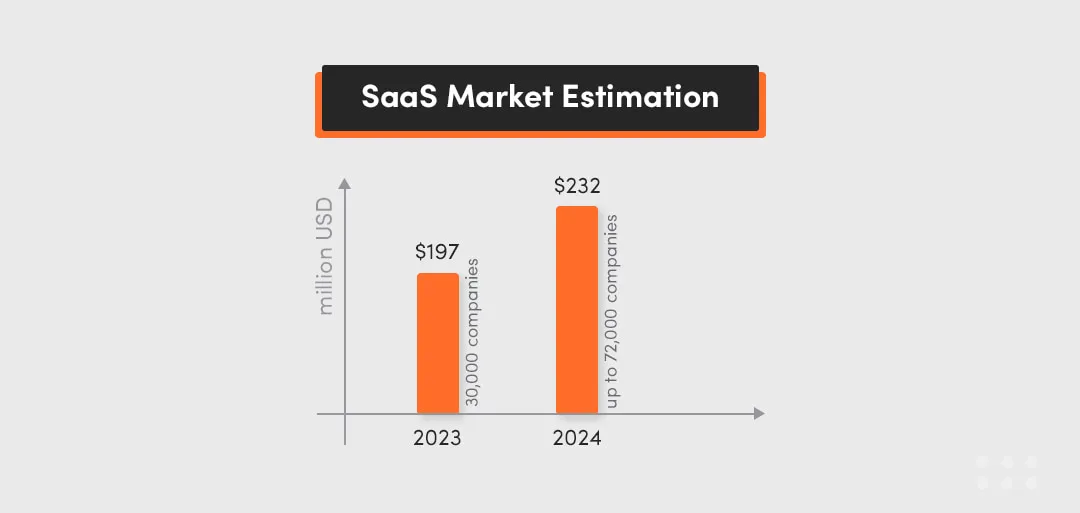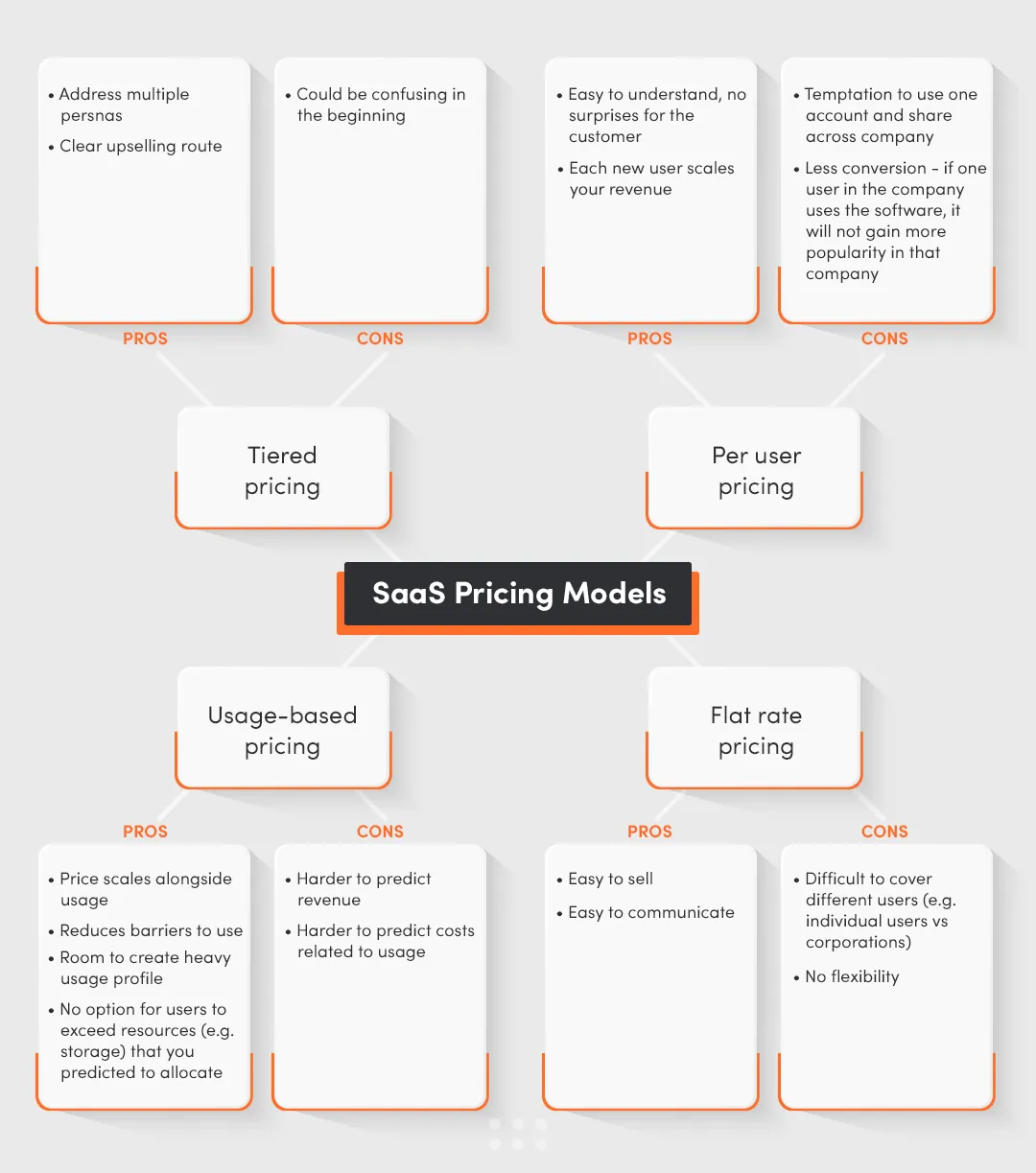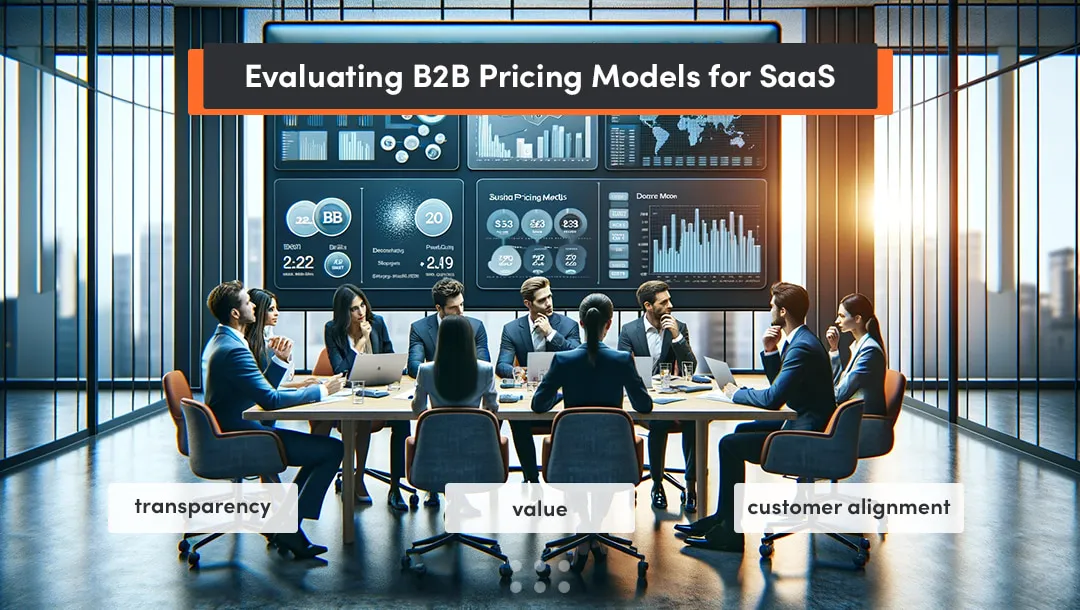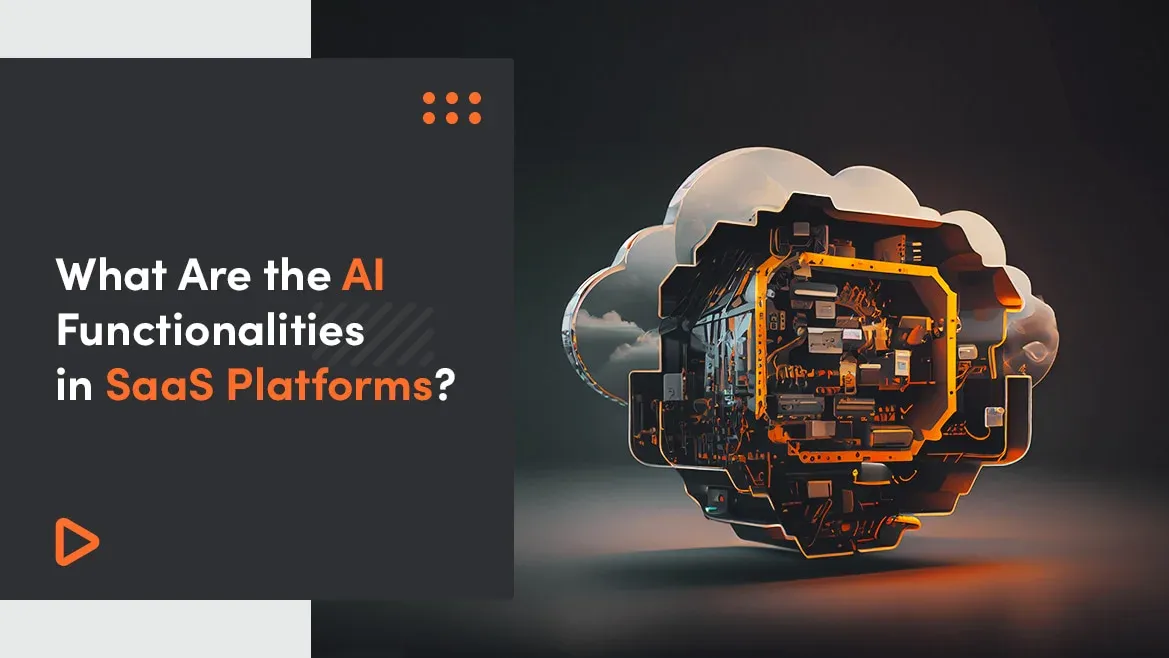Software as a Service has emerged as a pivotal element in the digital transformation of companies across the globe. It is a service model that enables businesses to access software applications over the Internet, eliminating the need for internal infrastructure or technical maintenance. This innovative delivery model has proven to be of immense relevance to most SaaS companies of all sizes, offering the scalability, flexibility, and cost efficiency essential for thriving in the modern marketplace.

The overall SaaS market is also on an upward trajectory, with an estimated worth of $197 billion in 2023 and a forecast to reach $232 billion by 2024. Additionally, the number of SaaS companies is projected to increase from around 30,000 in 2023 to up to 72,000.
These statistics indicate a shift towards types of SaaS pricing models that provide greater flexibility and value to an average customer, with freemium pricing model accounts and usage-based pricing gaining popularity. The growth in the number of SaaS companies and the market's value also suggests a competitive environment where pricing strategies could be key differentiators.
With the increasing reliance on SaaS solutions, the idea behind setting the right pricing strategy has become ever more critical.
A well-created SaaS pricing strategy is not just about setting the right price points - it’s about constructing a pricing architecture that resonates with customers’ expectations and drives business growth.
We could even say, that it’s a strategic decision that can significantly impact user adoption, customer retention, and revenue generation.
As we delve into the nuances of SaaS software pricing models, it is crucial to understand that the chosen pricing options should serve as a bridge connecting the value provided by the service to the customer's willingness to pay. Whether it’s flat-rate pricing that appeals to those seeking simplicity or usage-based pricing that aligns cost with consumption, the pricing model is a declaration of the business’s understanding of its customer base.
Therefore, identifying the right pricing strategy and model is essential for SaaS companies aiming to secure a competitive edge in an increasingly crowded market.
In this article, you will learn:
- What are SaaS pricing strategies?
- What impact does it have on a business?
- How does it change over time?
- B2B SaaS pricing models
- Impact on scalability and enterprise solutions
- How to choose a SaaS pricing model?
- Security and compliance in SaaS pricing
- CTO checklist to evaluate a pricing model
What Are SaaS Pricing Models and Why You Have to Understand Them?
SaaS Pricing models refer to the pricing strategies and structures that SaaS businesses employ to determine how their services are billed and monetized. It's the financial framework that dictates how customers are charged for accessing and using cloud-based software. This pricing is not one-size-fits-all - it can take various forms, from subscription-based models to usage pricing plans or fixed monthly prices, each with different billing cycles and pricing tiers.
These models are crucial as they help to clearly show the value of the SaaS service to potential customers and allow to predict revenue for a SaaS company.
The shift in software development towards SaaS is a direct response to the evolving needs of many SaaS companies and consumers for more agile, scalable, and maintenance-free software solutions. Traditional software models, which typically involved heavy upfront investments in infrastructure and licenses, are being rapidly replaced by the SaaS model. This approach minimizes the initial investment, shifts the IT expenditure from a capital expense to an operating expense, and offers the flexibility of on-demand scalability. It's a transformation that reflects a broader move toward service-based economies and the increasing value placed on ongoing customer relationships over one-time sales.
This transition is underpinned by the growth of cloud computing, which has become the backbone of modern software delivery. As software providers migrate their services to the cloud, the SaaS pricing strategies they adopt are becoming increasingly innovative and varied, aiming to capture the diverse needs and preferences of a global customer base. Whether it's through a tiered pricing model that caters to different usage scales or through a freemium pricing model that lowers the barrier to entry, different pricing models are at the heart of how software services are consumed and paid for in the digital age.
Understanding SaaS software pricing models is, therefore, not only fundamental for SaaS companies in crafting their revenue strategies but also for customers who must navigate the options to find the best fit for their usage patterns and budgets. As such, any pricing model becomes a critical decision point that can determine the market success of a SaaS product and the financial viability of the provider.
What Are the Popular SaaS Pricing Models
The SaaS software pricing landscape offers various pricing strategy models that cater to the shifting demands of the market. In 2023, trends indicate a significant evolution in how these models are being deployed and perceived by both active users and sellers. We have selected the following types:

Flat-rate Pricing Model
Flat-rate pricing is the simplest form, where customers pay a single fixed fee for accessing the software. Despite the market’s complexity, flat-rate pricing remains relevant for its transparency and ease of understanding among other pricing strategies.
Pros
- easy to sell
- easy to communicate
Cons
- difficult to cover different users (e.g. individual users vs corporations)
- no flexibility
Usage-based Pricing Model
Reflecting an increasing market preference, usage-based models offer flexibility and scalability. They align costs with the actual consumption of services, an attractive offer for businesses mindful of operational efficiencies.
Pros
- price scale alongside usage
- reduces barriers to use
- room to create a heavy usage profile
- no option for users to exceed resources (e.g. storage) that you predicted to allocate
Cons
- harder to predict revenue
- harder to predict costs related to usage
Tiered Pricing Model
Tiered pricing offers various levels of service at different price points and can accommodate the diverse needs of a broad customer base, from small businesses to large enterprises.
Pros
- address multiple personas
- clear upselling route
Cons
- could be confusing in the beginning
Per User Pricing Model
The per-user pricing model charges based on the number of active users or accounts. It is straightforward and scales proportionally to the size of the customer's team. Active user pricing is especially needed for companies that want to offer additional educational sources to their workers.
Pros
- easy to understand, no surprises for the customer
- each new user scales your revenue
Cons
- temptation to use one account and share across the company
- less conversion - if one user in the company uses the software, it will not gain more popularity in that company
Freemium Pricing Model
The freemium model provides basic services for free while charging for advanced features, the freemium model is a popular strategy for customer acquisition and upselling. New customers get the possibility to test the software and see if it can bring them more value.
Case Study - Vendr
A 2023 case study from Vendr highlights the current state of SaaS pricing models. Vendr processed over 3,000 transactions, revealing a trend toward price transparency and a decrease in average discounts, suggesting a market shift toward more standardized pricing. The average Annualized Contract Value (ACV) has dropped significantly, indicating that buyers are prioritizing efficiency by selecting more affordable tiers and reducing expenses, even as some SaaS providers announce price hikes to counterbalance lower contract values.
These insights underscore the importance of carefully selecting a SaaS pricing model that not only reflects the value of the software but also aligns with current market trends and customer purchasing behaviors.
Try our developers.
Free for 2 weeks.
No risk. Just results. Get a feel for our process, speed, and quality — work with our developers for a trial sprint and see why global companies choose Selleo.
Why Is It More Reasonable to Propose a Freemium Plan in Later Stages?
There is a significant risk when offering too much for free. Especially, if you think about getting feedback from your customers, it's much harder to maintain focus on essential feedback - these are 0.5 - 3% of customers from all users, making it even more challenging to filter feedback that can increase future conversion.
Finding the right price for the product is a difficult process, and the freemium plan delays it.
It’s even more crucial to understand that free users are not entirely free due to maintenance costs.
How to Do It Better?
- In the beginning, focus on one type of customer, but charge them, while validating the value proposition.
- Look for early adopters among users - they are less price-sensitive and more value-seeking.
- Use a free trial plan to force a conversion decision within a timeframe you control.
- Offer a free plan ONLY when you know the usage pattern and can identify the moment when the user will want to grow.
Tactics for subscription models

Step 1: Raise prices
Raising prices requires qualitative and quantitative research about the pricing to help segment the customers, based on common attributes, their feature preferences, and willingness to pay.
- If the NPS survey includes comments like “Very affordable”, or “Good value for money” - you may consider raising the price.
- In cancellation surveys, people almost never select the “Price is too high” reason.
- You have a sticky product (switching to an alternative product requires a lot of effort and costs).
- If you consider raising the prices, a good moment to do it would be after releasing some major features, while highlighting the value your product delivers.
Step 2: Adjust subscription plans (tiers)
- The most popular SaaS pricing model is GBB.
- GBB (Good-Better-Best) - pricing strategy based on three price levels for different product/service bundles
- A common rule of thumb for customer distribution is 40-50-10 which emphasizes the middle-tier package
- If the majority choose the cheapest plan (e.g. 70%), then probably it offers too many features
- If a lot of people choose the most expensive plan (e.g. 30%), then consider getting rid of the cheapest one and divide the best plan into two separate ones
Step 3: Apply smart discounts
- 12 months off charge for the annual plan will result in higher retention
- 50% off for the first 3 months could work particularly well for sticky products
- engage customers in the onboarding process
Evaluating B2B Pricing Models for SaaS

This approach is different from B2C models, with a focus on value delivery at scale and long-term customer relationships. B2B SaaS pricing must account for the complex and varied needs of businesses, including integration with existing systems, customization, and added support services. It often results in tiered pricing models based on usage, feature access, or per-user pricing, allowing for flexibility as an organization grows.
Differences between B2B and B2C SaaS models also emerge in sales cycles, negotiation processes, and purchasing decisions. B2B transactions tend to be larger, involve more stakeholders, and require a clear ROI, whereas B2C is typically more transactional with individual users making quicker decisions.
Key considerations for B2B SaaS pricing include scalability to accommodate growing user numbers without increasing costs, and the provision of enterprise-grade solutions that offer security, reliability, and compliance features demanded by large organizations.
In crafting B2B SaaS pricing models, transparency, value, and customer alignment are crucial, ensuring that the pricing strategy not only attracts customers but also fosters loyalty and expansion within client organizations.
What Factors You Must Consider When Choosing SaaS Pricing Models?
Choosing the optimal SaaS pricing model is an important decision that requires a deep understanding of your target market and the value of your product. Knowing what your customers value, and how much they are willing to pay for it, is fundamental to effectively set the pricing strategy of your SaaS product.
Evaluating the pricing and market position of other enterprise companies provides essential insights that can influence your pricing strategy. It is crucial to understand where your product is placed in the market and how much value it brings, in order to price it accordingly.
In considering these factors, a good SaaS pricing strategy or model should reflect the intersection of your product's value, the competitive landscape, and the unique needs and behaviors of your target market.
Case Studies: Successful SaaS Pricing Strategies
As far as SaaS pricing strategies are concerned, 2023 has seen innovative approaches across various sectors. One of which was taken by Basecamp which stands out with its flat-rate pricing strategy. For $99 a month, Basecamp offers 500 GB of storage, unlimited projects, and an unlimited number of users. This model is particularly successful because it simplifies the decision-making process for teams, offering predictability in budgeting and the reassurance that costs won’t escalate with team expansion or project proliferation.
Twilio showcases the effectiveness of usage-based pricing in the communication sector. As a cross-platform communication tool, Twilio provides a variety of messaging options, including SMS, voice, video, and email. They incentivize adoption by offering a set number of free credits to start, then transitioning to a pay-per-message model. This approach aligns costs directly with user consumption, appealing to businesses that value operational efficiency and scalability.
Zapier offers a compelling example of a tiered pricing model in action. By structuring it around five distinct pricing tiers, from a free option to a top-tier 'Company' level at $599 per month, Zapier caters to a broad range of automation needs. This allows users, from individual freelancers to large companies, to find pricing packages that match their workflow requirements and budget constraints.
These examples showcase that a successful SaaS pricing strategy in 2023 is one that offers clarity, value, and flexibility to customers. Whether it’s through the predictability of flat-rate pricing, the flexibility of usage-based pricing, or the variety offered by tiered pricing, these models illustrate the importance of aligning prices with customer needs and usage patterns.
Is Security and Compliance in SaaS Companies Important?
In the SaaS industry, security and compliance are not just operational requirements - they are significant factors that influence customer trust and decision-making. This is particularly true in sectors where data sensitivity is paramount, such as Healthcare, Finance, and enterprise HR solutions. High-security measures may even help reduce customer acquisition costs as they increase the overall trust in the given solution.
Read also: Compliance and Regulations in Healthcare Software Development - Why Is This so Important?
How Security and Compliance Can Be a Unique Selling Point?
For a SaaS business, robust security and stringent compliance standards can be leveraged as key differentiators when considering competitor-based pricing. Businesses are more likely to subscribe to a SaaS solution if they are confident that it can protect their data and ensure regulatory compliance. This is because the cost of data breaches and non-compliance can be severe, including financial penalties, reputational damage, and operational disruptions.
Integrating These Concerns Into the Pricing Strategy
Integrating security and compliance into the pricing model requires a delicate balance. SaaS companies must communicate the value of these features without making the service prohibitively expensive. One approach is to include basic security features in the base price of the service, with the option to purchase additional, premium security and compliance features. This allows customers to tailor their subscriptions according to their risk profile and compliance needs.
Alternatively, a SaaS company might adopt a tiered pricing model that reflects varying levels of security and compliance service, with higher tiers offering more advanced protections for a higher price. This not only caters to the diverse needs of businesses but also allows customers to scale their security investments as their business grows and gets more value in the future.
Final Thoughts
Security and compliance features are integral to the value proposition of a SaaS product and should be carefully considered in the pricing strategy.
By positioning these features as part of the core SaaS pricing strategy, providers can attract and retain customers who prioritize data protection and regulatory adherence.
In any given pricing model, these elements can serve as competitive advantages that justify the service's price point, ensuring customers feel their investment is directly contributing to their organization's safety and legal compliance and is not only about paying a monthly fee.
How to Select the Right SaaS Pricing Model That Improves Your Pricing Strategy - Checklist for Product Managers
For a product manager, selecting the appropriate SaaS pricing model is a strategic decision with wide-ranging implications. The chosen pricing model can affect everything from market adoption to long-term customer acquisition cost and the company's revenue generated. Here’s a simple checklist for product managers to consider before making this critical decision:

- Understand Customer Value – map out the value your product offers and how it solves customer problems.
- Market Analysis – research market trends, customer expectations, and how competitors pricing.
- Cost Structure – review your cost of service delivery to ensure the pricing model covers costs and generates a profit.
- Scalability – ensure the pricing model can scale with customer growth and usage without creating financial strain on the provider or the customer.
- Flexibility – consider whether the pricing model can adapt to future product enhancements and market changes.
- Simplicity – aim for the best pricing model that is easy for customers to understand and for your sales team to explain.
- Trial and Feedback – Implement a freemium pricing model and collect customer feedback to refine the solution to get a higher price in the future.
You Should Future-proof Your SaaS Pricing Strategy
Future-proofing a pricing strategy involves anticipating changes in technology, customer behavior, and market conditions. This might include offering different types of pricing models for SaaS to cater to a range of customers, providing options for customization, or planning for periodic reviews of the pricing structure to adapt to new market realities.
The Pivotal Role of the Product Manager in Developing the Best Pricing Strategy
The CTO’s role in developing a pricing strategy is pivotal because various pricing models often depend on the technical infrastructure and capabilities of the product. It's the CTO's responsibility to ensure the product can deliver the value promised by the pricing model at scale and to align the technical roadmap with the financial objectives of the strategy.
Conclusion
The analysis of the various aspects of SaaS pricing models highlights their critical role in the success of any SaaS business.
The right pricing model acts as a strategic tool, enabling businesses to capture value and drive sustainable growth. The selection process should be meticulous, considering factors like customer value perception, cost, market positioning, and competitive dynamics.
This article has highlighted the importance of a strategic approach to SaaS pricing models, advocating for solutions tailored to the unique needs of businesses. CTOs should weigh their options carefully, using the provided checklist to ensure their pricing strategy is scalable and adaptable to future changes.
Staying competitive in the SaaS industry is not just about innovation in technology but also about how that technology is priced. A well-thought-out pricing strategy is essential, as it directly influences customer satisfaction and overall business prosperity.





